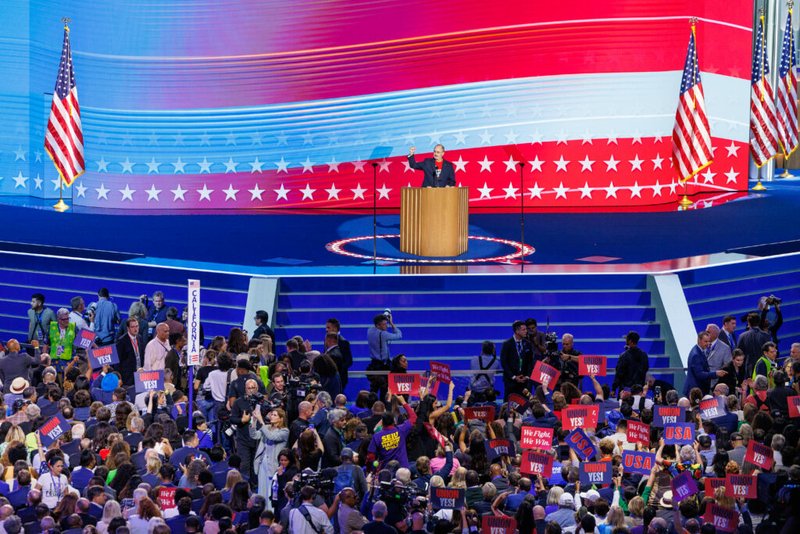UAW President Shawn Fain speaks at the Democratic National Convention in 2024. (Photo by Andrew Roth/Michigan Advance)
Who is credited with founding the holiday we celebrated Monday? According to History.com, some say it was a man named Peter McGuire, of the American Federation of Labor. Others say it was a man named Matthew Maguire, of the Central Labor Union who proposed it first. If spoken with an average gait, it’s safe to speak either name and still safely sound correct.
Unions have been on a winning streak recently, a trend I expect to continue for the foreseeable future. The trend is good for America, even when it’s inconvenient.
I rolled my eyes a little, OK, a lot, when the Hollywood writers and actors went on strike last year. It was the first time I had a personal stake in a walkout. I had done some, and hoped to do more, consulting on a film that was set to begin shooting in August. The strike caused the project to be shelved, ending my irrational fantasies of fame and fortune. That movie would have been bigger than “Barbie,” according to me.
What could these people who have already “made it” possibly have to strike about? Does Brad Pitt really need better terms? No. But the Writers Guild of America, followed by the Screen Actors Guild, are filled with creators and workers similar to every other industry. And just like industries whose labor struggles have been historically familiar, Hollywood’s impasse was also existential. These strikes became important because they have broadened the discussion.
Labor Day became a national holiday when the law creating it was signed by President Grover Cleveland on June 28, 1894, during his second term. The gesture didn’t make that otherwise unoriginal thinker popular enough to encourage him to even seek a third term. About 130 years later, politics and organized labor continue to be synonymous.
President Franklin Roosevelt signed the National Labor Relations Act in 1935 as part of his New Deal platform to try and drag the nation out of the poverty of the Great Depression. The NLRA gave workers the right to unionize and bargain collectively. The famous Flint sit-down strike began the following year, consolidating local unions into what became the United Auto Workers.
The present
Shawn Fain, president of the UAW and Kokomo native, led an aggressive strategy last year in contract negotiations with the Big Three. The wage-increase demands led to a strike beginning in September, less than six months after Fain was elected president. The Big Three got rolled in the standoff, ultimately agreeing to a 36% pay raise. Virtually all of the other non-UAW auto manufacturers followed suit shortly afterward.
President Joe Biden was the first sitting president to ever walk a picket line when he joined UAW strikers in Wayne County, Michigan last September. The pro-union, income-inequality presidential campaigns of Sen. Bernie Sanders in 2016 and 2020 distinctly connected with young workers, an important ingredient. These things have unquestionably helped fuel the current resurgence of the organized labor movement.
Fain was on the stage of the Democratic National Convention in August, and his credibility is sky high at a pivotal political moment. That moment is awkward to say the least. Many workers, who had been part of the Democrat base for generations, have migrated to support Donald Trump and his MAGA movement over the past decade. But the Republican party’s leadership is unable to fully solidify that relationship because in the end, union labor support just isn’t in the GOP’s DNA.
The International Brotherhood of Teamsters President Sean O’Brien made waves earlier in the summer when he spoke at the Republican National Convention. Again, it’s an awkward moment as the union hasn’t officially endorsed a candidate, and the race has changed dramatically since that convention. “You saw how happy Trump and Vance were, even though everything that O’Brien said went against the Republican platform,” says Kate Bronfenbrenner, senior professor at Cornell University’s School of Industrial and Labor Relations.
There are many factors that have contributed to the rise in unionization, but none are larger than the pandemic. Movements like this usually start, or restart, from a clear catalyst like worker safety and value issues that were intense in many industries in 2020. Couple that obvious challenge with the extreme income inequality that has grown since the sharp decline in union activity the past three decades, and the resurgence would seem inevitable.
The real question remains about how long the resurgence will last, and how broadly its impact will be. The presence of new union activity at Starbucks, Amazon, Microsoft and Apple would indicate new economies will experience similar pressures that old ones have faced for more than a century.
Whether McGuire or Maguire started all of this, I think they both would be proud what it all means today.
GET THE MORNING HEADLINES DELIVERED TO YOUR INBOX

